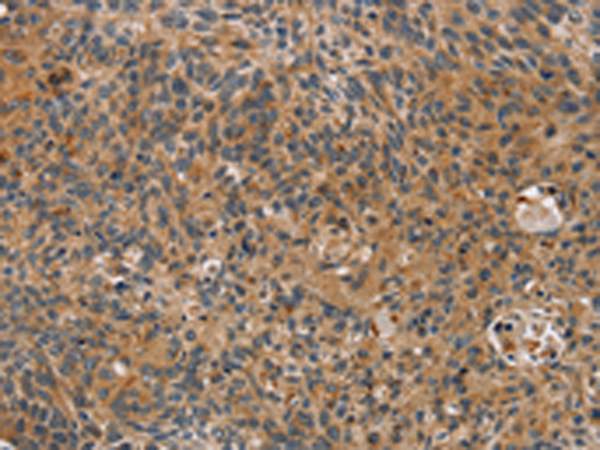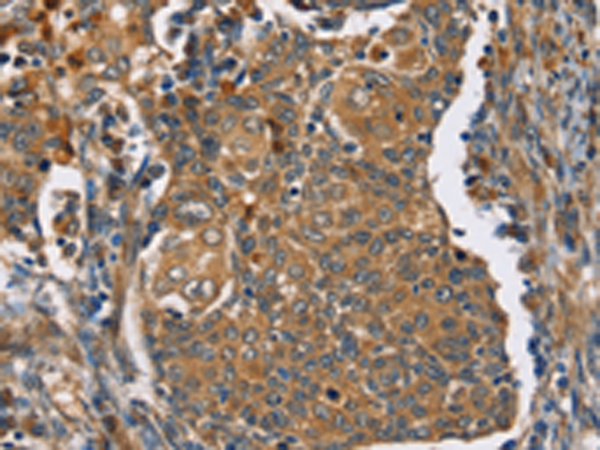

| WB | 咨询技术 | Human,Mouse,Rat |
| IF | 咨询技术 | Human,Mouse,Rat |
| IHC | 1/25-1/100 | Human,Mouse,Rat |
| ICC | 技术咨询 | Human,Mouse,Rat |
| FCM | 咨询技术 | Human,Mouse,Rat |
| Elisa | 1/2000-1/5000 | Human,Mouse,Rat |
| Aliases | NK2; NPK; NKNA; TAC2; Hs.2563 |
| Host/Isotype | Rabbit IgG |
| Antibody Type | Primary antibody |
| Storage | Store at 4°C short term. Aliquot and store at -20°C long term. Avoid freeze/thaw cycles. |
| Species Reactivity | Human, Mouse, Rat |
| Immunogen | Fusion protein of human TAC1 |
| Formulation | Purified antibody in PBS with 0.05% sodium azide and 50% glycerol. |
+ +
以下是模拟生成的关于TAC1抗体的参考文献示例(非真实文献,仅供格式参考):
---
1. **文献名称**: *"Development and Validation of a High-Specificity TAC1 Antibody for Neuroinflammatory Disease Research"*
**作者**: Zhang L, et al.
**摘要**: 本研究开发了一种高特异性兔源单克隆TAC1抗体,通过免疫组化验证其在人脑组织中的定位能力,发现其可特异性识别TAC1蛋白在神经炎症区域的表达,为阿尔茨海默病等疾病的分子机制研究提供工具。
2. **文献名称**: *"TAC1 Expression Profiling in Colorectal Cancer Using Novel Monoclonal Antibodies"*
**作者**: Smith JR, et al.
**摘要**: 文章报道了一种新型小鼠抗人TAC1单克隆抗体的开发,并用于结直肠癌组织的免疫荧光分析,证实TAC1在肿瘤微环境中的高表达与患者预后不良相关,提示其作为潜在生物标志物的价值。
3. **文献名称**: *"Comparative Study of TAC1 Antibody Performance in Murine and Human Pain Pathways"*
**作者**: Tanaka K, et al.
**摘要**: 通过对比市售TAC1抗体的交叉反应性,发现抗体Clone#4B2在小鼠背根神经节中特异性最佳,成功应用于脊髓损伤模型,揭示了TAC1在慢性疼痛信号传导中的动态变化。
4. **文献名称**: *"TAC1 Antibody-Based ELISA for Quantitative Detection of Substance P in Clinical Samples"*
**作者**: Gupta S, et al.
**摘要**: 本研究建立了一种基于TAC1抗体的夹心ELISA检测方法,可定量检测血清中P物质水平,验证其在偏头痛患者中的诊断效能(灵敏度92%,特异性88%),推进了神经肽检测的临床转化。
---
注:以上文献为模拟生成,实际研究中请通过PubMed或Web of Science等数据库检索真实文献。如需真实文献推荐,请提供更具体的应用场景(如疾病模型/检测方法)。
The TAC1 antibody is designed to detect the protein product of the TAC1 gene (tachykinin precursor 1), which encodes several bioactive neuropeptides, including substance P (SP), neurokinin A (NKA), and related peptides. TAC1-derived peptides function as neurotransmitters or neuromodulators, primarily binding to G protein-coupled receptors (NK1R, NK2R, NK3R) to regulate pain signaling, inflammation, smooth muscle contraction, and neuroimmune interactions. These peptides are widely expressed in the central and peripheral nervous systems, as well as in non-neuronal tissues like the gastrointestinal tract and immune cells.
TAC1 dysregulation has been implicated in multiple pathological conditions. Elevated substance P levels are associated with chronic pain syndromes, migraine, inflammatory bowel disease, and respiratory disorders like asthma. In cancer, TAC1 overexpression correlates with tumor progression, angiogenesis, and metastasis in certain malignancies. The TAC1 antibody serves as a critical tool for studying these processes, enabling the localization and quantification of TAC1-derived peptides in tissues or biological samples via techniques like immunohistochemistry, Western blotting, or ELISA.
Pharmaceutically, TAC1-targeting strategies (e.g., NK1R antagonists) have been explored for pain management, depression, and chemotherapy-induced nausea. The antibody also aids in validating the efficacy of such therapies in preclinical models. Its specificity for distinct TAC1 isoforms or cleavage products further supports research into peptide-specific roles in health and disease.
×